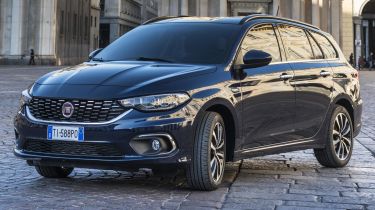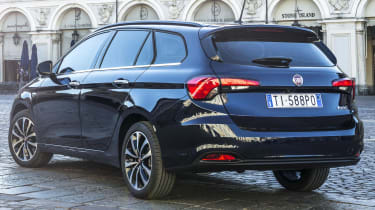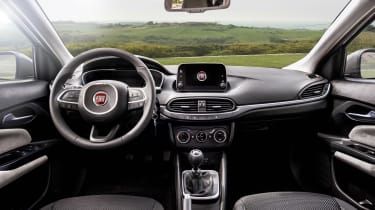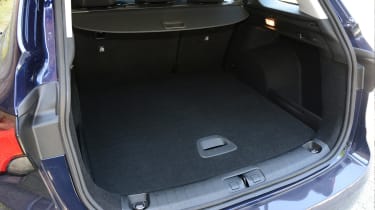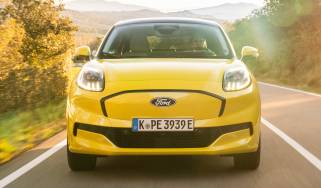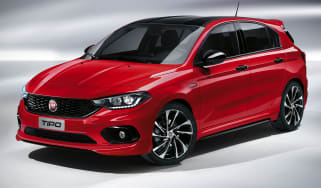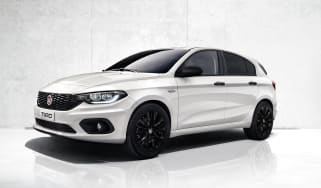Fiat Tipo Station Wagon estate review (2016-2021)
"The Fiat Tipo Station Wagon is a practical, spacious and generously equipped family estate car, let down by an uninspiring engine range and dull driving experience"
Pros
- Entry-level models offer good value
- Generous standard equipment
- Larger boot than most rivals
Cons
- Dated-feeling interior
- Uninspiring driving experience
- Less of a bargain with better engines
Like its hatchback sibling, the Fiat Tipo Station Wagon estate is an affordable, comfortable and sensible family car. It’s by no means the last word in driver appeal or stylish looks, but the Tipo Station Wagon is a competent car with a larger boot than many of its rivals. As long as you’re happy shelling out an extra £1,500, the Tipo estate actually makes more sense than the hatchback, thanks to the added space and practicality it offers. If you’re thinking of buying a Ford Focus Estate, Kia Ceed Sportswagon or SEAT Leon Estate, it’s well worth giving the Tipo Station Wagon a look – partly because the entry-level model is significantly cheaper than almost all of its rivals.
The Tipo Station Wagon does require you to make a few sacrifices, though. Noticeable body lean when cornering discourages enthusiastic driving, while the interior feels solidly built but has a dated feel to it. Equipment is a little sparse on the cheaper model too. These compromises are by no means disastrous, but they do make the Tipo estate a less appealing car than rivals from Ford and Kia.
 Best estate cars on sale in 2025
Best estate cars on sale in 2025
Fiat used to offer a choice of three petrol engines and two diesels with the Tipo Station Wagon but now there’s just one 1.0-litre petrol to choose from. It produces 99bhp and has a slightly lethargic 0-62mph time of 12 seconds but is quite a modern engine and will manage up to 50mpg. All cars come with air-conditioning, rear parking sensors, DAB radio, Bluetooth phone connectivity, cruise control, split-folding rear seats, power-adjustable wing mirrors and remote central locking.
More reviews
In-depth reviews
The Tipo Life version adds welcome styling upgrades including 17-inch alloy wheels, plus automatic air conditioning and two seven-inch screens. One’s in between the dials and the other is for infotainment; it features Apple CarPlay and Android Auto so you can use your phone’s navigation and media apps. The Life trim also includes LED headlights and is the one to pick if you can stretch to it.
MPG, running costs & CO2
We’re glad to see that Fiat has given the Tipo Station Wagon a more modern and efficient engine, even if it’s not the most powerful. The 1.0-litre turbocharged petrol engine is capable of 50.4mpg, which is pretty competitive with the Kia Ceed Sportswagon’s 53.3mpg figure. Fiat’s previous 1.4-litre petrol engines could only muster 37mpg, so the new engine will be considerably cheaper to run. CO2 emissions of 126g/km are better than before too, which puts the Tipo in a reasonable Benefit-in-Kind band for company-car users.
The new petrol engine is just as economical as the old 1.6-litre 118bhp diesel engine, so it’s no wonder the only choice is now petrol. Choosing a diesel engine for the Tipo also saw its price rise quite sharply.
If finance offers on the Tipo aren’t as good as you’d expect, it’s because the Tipo tends to lose a lot of its initial value quite quickly.
VED (road tax) for all models costs the standard rate from the second year onwards (the first year’s VED is wrapped up in the price of the car). The Tipo gets a three-year warranty, with unlimited mileage in the first two years.
Engines, drive & performance
If you’re happy with a family estate that prioritises comfort over driver enjoyment, the Tipo Station Wagon is definitely worth a look. Although it’s 20cm longer than the hatchback, the Tipo Station Wagon doesn’t feel unwieldy around town, so parking is simple. Rear parking sensors are now standard, to take some of the stress out of reversing.
The soft suspension means you’re well insulated from potholes and poor surfaces, although this results in excessive body lean, which develops noticeably when cornering. The steering is also unimpressive, providing little feedback through the wheel and making it hard to judge how much grip the front wheels have. The Tipo Station Wagon always feels secure on the road, but if you want to press on, you’ll be discouraged from doing so by the steering and suspension.
It’s a similar story with performance: the Tipo Station Wagon’s engine has an adequate amount of power, but there’s no stand-out performer; the estate is also slightly slower than the equivalent hatchback with the same engine.
The 99bhp 1.0-litre petrol gets the car from 0-62mph in 12 seconds, which is around a second slower than a Kia Ceed Sportswagon or Ford Focus Estate with 1.0-litre engines. All Tipo estates now come with a manual gearbox; an automatic gearbox is no longer an option.
Interior & comfort
Climb inside the Tipo Station Wagon and you’ll find a simple and easy-to-use dashboard, which is solidly built and features plenty of equipment. It does feel somewhat dated though, with scratchy plastics, old-fashioned fabric patterns and a slightly drab overall design. Considering the flair and élan of the Fiat 500 city car’s dashboard, it’s disappointing to see more of an effort wasn’t made to give the Tipo’s interior greater appeal.
To keep things simple, Fiat offers the Tipo Station Wagon in two trim levels. All cars come with DAB radio, USB and Bluetooth phone connectivity, air-conditioning, cruise control and remote central locking. Life models add a few styling touches and a seven-inch touchscreen with Apple CarPlay, Android Auto and a range of online services.
The second trim also adds a leather steering wheel, 17-inch alloy wheels, LED lights, adaptive cruise control and electric rear windows. It does cost £2,000 more than the basic car but features a generous amount of equipment.
Options depend on which trim you choose. You can only add four extras onto the base trim, one of which is a full-size spare wheel, and the choice of paint colours is limited to seven shades. For the Life trim, you can choose two extra colours, plus sat nav, a reversing camera, front sensors, heated front seats, keyless entry and more, and all are reasonably priced - although add too many and the Tipo won’t look good value against its rivals.
Practicality & boot space
While the Tipo Station Wagon feels somewhat dowdy inside, there’s no denying it’s spacious and practical. The extra luggage space of the estate over the hatchback adds to this version’s appeal, while rear-seat passengers also get more headroom, as the Station Wagon does without the sloping roof of the hatchback. All passengers get plenty of legroom and, while it’s not an exciting place to sit, the Tipo is comfortable and light inside
The 550-litre boot also impresses: it’s larger than what you get in most of the Tipo Station Wagon’s rivals, including the Renault Megane Sport Tourer estate. Split-folding rear seats are standard, and while they don’t fold totally flat, the seat bases can be folded forward to create a flat load bay – although many manufacturers manage to offer this feature without requiring you to move the bases. The Station Wagon also gets extra storage compartments under the floor and in the sides of the boot, as well as some useful bag hooks and four load-retaining brackets.
Reliability & safety
Fiat hasn’t had much to cheer about in our Driver Power owner satisfaction surveys in recent years. A 15th place finish in our 30-strong manufacturer list in 2019 was the highest the brand has been for a number of years, and in 2021 it has dropped to 26th out of 29 carmakers.
The Tipo Station Wagon feels built to last, while its relative mechanical simplicity should help dependability.
The Fiat Tipo hatchback has been tested by Euro NCAP, and its four-star score applies to the estate too. Some Tipos get a three-star rating in other countries, but all UK models get autonomous emergency braking fitted as standard - and the higher score as a result. Mandatory safety equipment like electronic stability control, anti-lock brakes and ISOFIX points for child seats are obviously all present and correct, too, while lane-keeping assist and a driver fatigue monitor are also fitted now.

